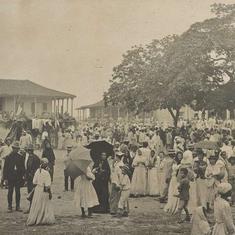In one “ghost” story by Satyajit Ray, a well-to-do writer – an intellectual – is stranded by a farm on a deserted road. The scarecrow guarding the crops makes for an eerie company. The longer the writer looks at the scarecrow, the more human it appears to be. Especially the clothes that it has been made to wear. The shirt, torn and discoloured, looks familiar too. When the writer eventually dozes off, he dreams of the servant he had fired on charges of thievery. He used to wear a similar shirt. The servant had denied stealing his master’s watch but the writer was not interested in hearing him out. In the dream, the servant tells him where he suspects the watch has disappeared to. The writer wakes up and eventually makes his way home. On searching the spot that the servant had spoken of in his dream, he finds his watch safe and secure, ticking away.
A haunted past
Satyajit Ray’s ghost stories – written with the young reader in mind – have been recently published as Ghosts, Supernatural, and Tales of the Uncanny by Puffin. The fifteen stories in the collection (translated primarily by Gopa Majumdar, with two by Indrani Majumdar and another two by the author) are neither gory nor horrifying, but delightfully spooky. Well-suited for children (and readers of all ages, really), the stories speak to how class conflicts, colonial hangover, animal cruelty, bad childhood memories, and guilt create horror later in our lives. There are no possessed children in these stories – the young are blemish-free, but as years pile on, callousness and cruelty become second nature, turning each of us into perpetrators of horror.
First published in the Bengali children’s magazine Sandesh, each of the stories is accompanied by Ray’s beautiful illustrations. I must have spent a minute or two admiring the ingenuity of his calligraphy and sketches.
Two stories in the collection, “Anath Babu’s Terror” and “Mr Brown’s Cottage”, were adapted for the screen by Sandip Ray for his 2012 movie, Jekhane Bhooter Bhoy. In “Anath Babu’s Terror”, a ghost hunter goes to a haunted house in search of an elusive ghost. The ghost does appear but will Anath Babu live to tell the tale? “Mr Brown’s Cottage” is another haunted house story set in the erstwhile remote Fraser Town in Bangalore. After learning about a certain Simon from Mr Brown’s cheaply purchased diary, the protagonist sets off for the cottage, wondering who this Simon might be. In both stories, the men are propelled by curiosity as they try to uncover mysteries that have lain buried for many years. My introduction to “Mr Brown’s Cottage” was as a radio play, and I remember being adequately thrilled when the big revelation came. The story about the scarecrow and the writer was adapted as “Kagtarua” by Sandip Ray in 2014 for the movie Chaar.
Satyajit Ray was a young man when India gained independence. He had witnessed some of the worst atrocities of colonialism and later, he also saw how difficult it was to rouse from the colonial hangover. This makes for an interesting subject in ghost stories. In “Indigo”, Ray imagines what the coloniser’s guilt might look like, whereas in “The First-Class Compartment”, an Indian man who derides everything Indian is reminded of his place when the ghost of a white sahib calls him a “nigger” and threatens to throw him off the coupé he is travelling in. The ghosts of history do not die so easily.
Phantoms of the mind
Dolls have proven themselves as useful mediums for ghosts. In “Bhuto” and “Fritz”, the dolls of a child and a ventriloquist are not inanimate objects, but those capable of feeling human emotions. The dolls are subjected to neglect and indifference, and in “Bhuto”, the doll is also a medium of the protagonist’s arrogance. In the end, the dolls come alive to teach a lesson that the humans were long overdue.
The most remarkable stories in the collection – “Ratan Babu and That Man” and “Khagam” – also happen to be translated by Ray. The two stories are as different from each other as they can be. In “Ratan Babu and That Man”, a man is surprised to find another person who is so similar to him in temperament and mannerisms. But soon, it starts to bug him. In “Khagam”, the senseless killing of a snake costs a man dearly. In fact, Ray seems to suggest that animal cruelty is one of the most horrific crimes that a human being is capable of, making it one of the recurring themes in his stories. Another affecting story on animal cruelty is “A Strange Night for Mr Shasmal”. Other animals turn up at Mr Shasmal’s home to make him pay for killing a dog.
No ghost story collection is complete without a delectable vampire story. “The Vicious Vampire” is a story about just that – a vicious vampire. However, the initial tone of the story is somewhat comical. A man, deathly terrified of bats, finds the animal hanging upside down in the house where he is vacationing. But this isn’t the end of his troubles, for he will soon cross paths with the local vampire.
Ray’s ghost stories take the readers to every corner of the country. His protagonists – all men! – encounter these vicious, scary, (and sometimes) anxious ghosts in small towns and villages. From remote sites in Rajasthan to Karnataka and Bihar to West Bengal, the ghosts appear in front of only those who seek them. Deliciously unnerving and pleasurably unsettling, Ray’s ghosts are phantoms of the mind – and not so much of material.

Ghosts, Supernatural and Tales of the Uncanny, written and illustrated by Satyajit Ray, translated from the Bengali by the author, Gopa Majumdar, and Indrani Majumdar, Puffin.










